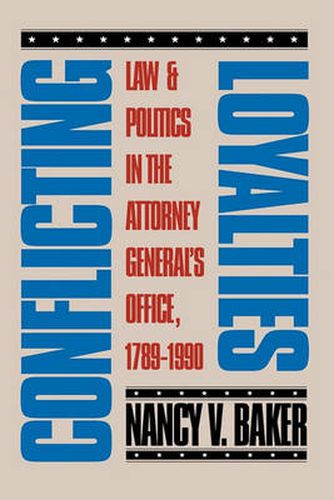Readings Newsletter
Become a Readings Member to make your shopping experience even easier.
Sign in or sign up for free!
You’re not far away from qualifying for FREE standard shipping within Australia
You’ve qualified for FREE standard shipping within Australia
The cart is loading…






This title is printed to order. This book may have been self-published. If so, we cannot guarantee the quality of the content. In the main most books will have gone through the editing process however some may not. We therefore suggest that you be aware of this before ordering this book. If in doubt check either the author or publisher’s details as we are unable to accept any returns unless they are faulty. Please contact us if you have any questions.
The US Attorney General is forever caught between competing demands: on one side, his political duties as cabinet appointee and adviser to the president; on the other, his quasi-judicial responsibilities as chief law officer of the nation. In theory, the two sets of responsibilities coexist peacefully. In reality they often clash. In
Conflicting Loyalties , political scientist Nancy Baker provides a comprehensive analysis of the history and structure of the office of the US Attorney General, an office that legal scholars have described as
schizophrenic . Her study documents how attorneys general have differed in their responses, seeing themselves either as advocates of the president or as neutral expounders of the law. Combining historical analysis with legal and political history, Baker shows how this implicit conflict has evolved from the earliest days of the Republic, when the attorney general was primarily an adviser, to the present day, when he administers the huge bureaucracy of the Department of Justice. Using both archival materials and personal interviews, Baker analyzes how the 75 men who have held the post of attorney general have managed the conflict of loyalties. In particular she focuses on Robert Kennedy, Edwin Messe, Elliot Richardson, Griffin Bell, Robert Jackson, Edward Levi, A. Mitchell Palmer, and Roger Taney. She also examines how the office has been affected by scandals in various administrations, including the Red Scare of 1919-20, Teapot Dome, Watergate, and Iran-Contra. The book concludes with an exploration of arguments for reforming the office.
$9.00 standard shipping within Australia
FREE standard shipping within Australia for orders over $100.00
Express & International shipping calculated at checkout
This title is printed to order. This book may have been self-published. If so, we cannot guarantee the quality of the content. In the main most books will have gone through the editing process however some may not. We therefore suggest that you be aware of this before ordering this book. If in doubt check either the author or publisher’s details as we are unable to accept any returns unless they are faulty. Please contact us if you have any questions.
The US Attorney General is forever caught between competing demands: on one side, his political duties as cabinet appointee and adviser to the president; on the other, his quasi-judicial responsibilities as chief law officer of the nation. In theory, the two sets of responsibilities coexist peacefully. In reality they often clash. In
Conflicting Loyalties , political scientist Nancy Baker provides a comprehensive analysis of the history and structure of the office of the US Attorney General, an office that legal scholars have described as
schizophrenic . Her study documents how attorneys general have differed in their responses, seeing themselves either as advocates of the president or as neutral expounders of the law. Combining historical analysis with legal and political history, Baker shows how this implicit conflict has evolved from the earliest days of the Republic, when the attorney general was primarily an adviser, to the present day, when he administers the huge bureaucracy of the Department of Justice. Using both archival materials and personal interviews, Baker analyzes how the 75 men who have held the post of attorney general have managed the conflict of loyalties. In particular she focuses on Robert Kennedy, Edwin Messe, Elliot Richardson, Griffin Bell, Robert Jackson, Edward Levi, A. Mitchell Palmer, and Roger Taney. She also examines how the office has been affected by scandals in various administrations, including the Red Scare of 1919-20, Teapot Dome, Watergate, and Iran-Contra. The book concludes with an exploration of arguments for reforming the office.